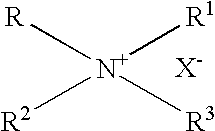Composition and method for road-film removal
a road film and composition technology, applied in detergent dyes, liquid soaps, detergent compounding agents, etc., can solve the problems of large variation in possible materials which may accumulate on the road, complex variation in possible materials, and commercially undesirable to have to provide a vast array of cleaning solutions or concentrates. , to achieve the effect of adding metal protection
- Summary
- Abstract
- Description
- Claims
- Application Information
AI Technical Summary
Benefits of technology
Problems solved by technology
Method used
Image
Examples
examples
[0082] T-1 An Alkaline Builder Concentrate Containing Aminocarboxylic Acid Chelating Agent. This Product is Often Applied with T-2.
1 Formula Breakdown for: Formula T-1 Percent Raw Material 85.05000 TETRASODIUM EDTA LIQ. 40% 2.70000 SODIUM HYDROXIDE 50% LIQUID 9.25000 SODIUM SILICATE SOLUTION, 2.40 SiO.sub.2 / Na.sub.2O 3.00000 AMINOTRIS(METHYLENE PHOSPHONIC ACID) 50% Total 100.00%
[0083] T-2 Formula Surfactant Concentrate Containing Poly[oxyalkylene]ammonium Cationic Surfactant. This Product is Often Applied with T-1.
2 Formula Breakdown for: T-2 Percent Raw Material 13.45 WATER, ZEOLITE SOFTENED 3.85 POTASSIUM HYDROXIDE, 45% LIQUID 16.50 SODIUM XYLENE SULFONATE, 40% 9.45 LINEAR DODECYL BENZENE SULFONIC ACID 97% 9.00 Fatty Alcohol (C.sub.12-C.sub.14) ethoxylate propoxylate Dehypon .TM. LS-54 7.75 LINEAR ALCOHOL 60-70% ETHOXYLATE; Neodol 25-7 31.50 Lauryl Dimethylamine Oxide, (30%) 9.0 Poly[oxyalkylene]ammonium Cationic Surfactant 4.50 MINERAL SPIRITS 5.00 Dipropylene Glycol Methyl Ether...
PUM
| Property | Measurement | Unit |
|---|---|---|
| temperature | aaaaa | aaaaa |
| pressure | aaaaa | aaaaa |
| temperature | aaaaa | aaaaa |
Abstract
Description
Claims
Application Information
 Login to View More
Login to View More - R&D
- Intellectual Property
- Life Sciences
- Materials
- Tech Scout
- Unparalleled Data Quality
- Higher Quality Content
- 60% Fewer Hallucinations
Browse by: Latest US Patents, China's latest patents, Technical Efficacy Thesaurus, Application Domain, Technology Topic, Popular Technical Reports.
© 2025 PatSnap. All rights reserved.Legal|Privacy policy|Modern Slavery Act Transparency Statement|Sitemap|About US| Contact US: help@patsnap.com



